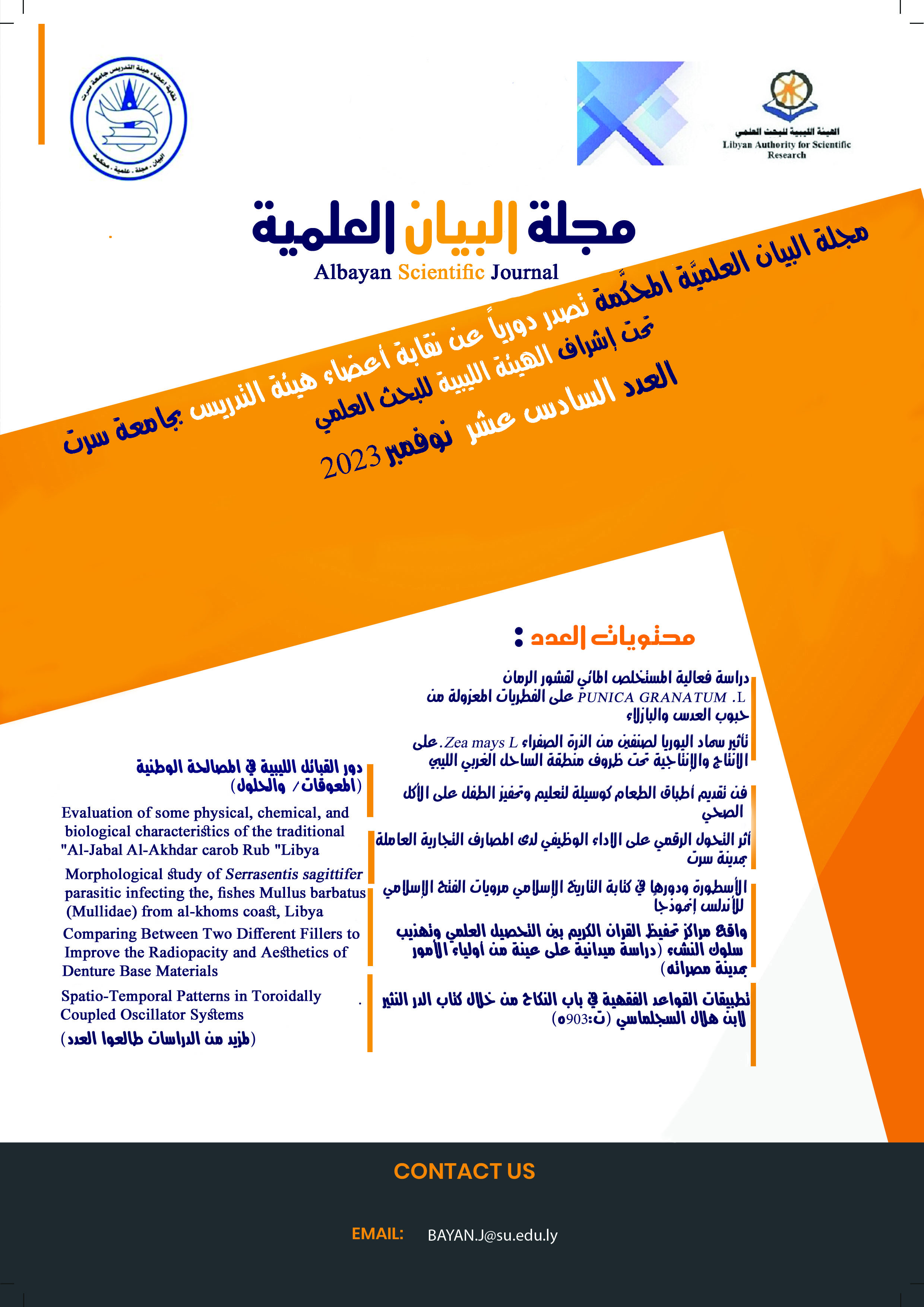تقييم أداء منهجية MEDALUS واختبار مدى وملاءمتها لمنطقة جنوب طبرق
DOI:
https://doi.org/10.37375/bsj.vi16.1936الكلمات المفتاحية:
تقييم أداء،، MEDALUS ،، جنوب طبرق،، ليبيا.الملخص
هذه الدراسة تم خلالها تطبيق نموذج البحر المتوسط لتقييم التصحر MEDALUS)) Mediterranean desertification and land use جنوب طبرق بعد تعديله ليلائم منطقة الدراسة. ويستند هذا النموذج على أربعة مؤشرات رئيسية، وهي جودة: التربة، الغطاء النباتي، المناخ، إدارة الأراضي، وقد تم اقصاء مؤشر جودة الأراضي، وذلك لعدم وجود أي نوع من الإدارة في منطقة الدراسة.
اضافة الى انتاج خريطة المنهجية الوصفية التي اعتمدت على الدراسات السابقة واراء الخبراء والدراسات الحقلية الأرضية لغرض التحقق من النتائج المتحصل عليها من نموذج MEDALUS، تم ادخال البيانات داخل نظم المعلومات الجغرافية ومعالجة كميات كبيرة من البيانات التي تصف الخصائص وتصنف المؤشرات الطبيعية التي لها تأثير واضح على التصحر في منطقة الدراسة. ومن خلال هذه الدراسة أمكننا مقارنة الخريطة المنتجة من نموذج MEDALUS بالخريطة المرجعية (خريطة المنهجية الوصفية) بالاعتماد على نتائج التحاليل الإحصائية: (اختبار دقة المستخدم، ومؤشر كابا) بعد اختيار (273) نقطة عشوائيا. كانت نتيجة اختبار دقة المستخدم (91%)، ومؤشر كابا (0.90) لخريطة حساسية التصحر (ESAI) Environmentally Sensitive Area. تبين الدراسة ان منهجية البحر المتوسط MEDALUS ملائمة بدقة عالية لتقييم التصحر في المنطقة.
المراجع
المراجع:
المراجع العربية:
ابوبكر، يوسف فرج، انيس، محمد ابزيو، عوض، محمد محمد (2018). دليل تقييم تدهور أراضي المراعي في إقليم الجبل الأخضر، المؤتمر العلمي السادس للبيئة والتنمية المستدامة بالمناطق الجافة وشبة الجافة، 23 – 25 يونيو، جامعة اجدابيا، ليبيا.
الشاعري، مدينة سالم (2002). تقرير الغطاء النباتي الطبيعي في الساحل الشمالي الشرقي (هضبة البطنان)، اللجنة الشعبية لشعبية البطنان.
الطنطاوي، عطية محمد (2005). تغير المناخ في ليبيا والتصحر سهل الجفارة، استخدام نظام المعلومات الجغرافية والنائية تقنيات الاستشعار، أطروحة يوهانس جوتنبرج جامعة ماينز الألمانية.
المحمد، حسين احمد (2017). مراقبة وتقييم المناظر الطبيعية في سرت(ليبيا)، مجلة العلوم الطبيعية والحياتية والتطبيقية، العدد الثالث، المجلد الأول.
الهيئة الحكومية الدولية المعنية بتغير المناخ (2007). تغير المناخ 2007، تقرير التقييم الرابع للهيئة الحكومية الدولية المعنية بتغير المناخ تقرير مجموعة العمل الأولى "أساس العلوم الفيزيائية". كامبريدج مطبعة الجامعة، نيويورك.
بالحسن، عادل ابريك محمد (2018). تدهور البيئة النباتي في حوض وادي الخبيري بهضبة الدفنة في ليبيا، مجلة أبحاث، 223 – 260. العدد 12.
بن محمود، خالد رمضان (1995). " الترب الليبية"، المجلس القومي للبحث العلمي، طرابلس، ليبيا.
جامعة عمر المختار (2005). " دراسة وتقييم الغطاء النباتي الطبيعي بمنطقة الجبل الأخضر"، التقرير النهائي، مؤسسة القذافي العالمية للجمعيات الخيرية، ليبيا.
خليفة، سيف الاسلام محمد احمد (2012). استخدام نظم المعلومات الجغرافية في إدارة أراضي مستجمع مياه وادي حبون شمال شرق ليبيا، رسالة ماجستير غير منشورة، جامعة عمر المختار، كلية الزراعة، قسم التربة والمياه.
محمد، السنوسي جادالله (2016). أثر الأنشطة البشرية في تدهور الغطاء النباتي في المنطقة الممتدة ما بين بلدتي سلنطة ومراوة بالجبل الأخضر، رسالة ماجستير غير منشورة، جامعة عمر المختار، كلية الآداب قسم الجغرافيا.
مركز البحوث الصناعية (1977). خريطة ليبيا الجيولوجية، لوحة البردية، الكتيب التفسيري.
المراجع الأجنبية:
Abdalrahman, Y (2013). Assessing land degradation and land use in the Libyan Al-jabal Alakhdar region, PhD Thesis, University Sheffield Hallam, UK.
Aburas, M. M (2009). Assessment of Soil Erodibility in Relation to Soil Degradation and land Use in Mediterranean Libya, PhD thesis. University of Newcastle upon Tyne.UK.
ACSAD (2002). The Arabic Center for the Studying of Dry Lands and Deserted Areas. Damascus, Syria.
ACSAD (2010). The Arabic Center for the Studying of Dry Lands and Deserted Areas. Damascus, Syria.
Ali, S. L., S. M. H .Jafari, and A .El Gadi (1989). Flora of Libya. Al-Fatah University, Tripoli, Libya.
Ben-Mahmoud, R., Mansur, S., and Al-Gomati, A (2003). Land degradation and desertification in Libya Tripoli: Land Degradation and Desertification Research Unit, Libyan Center for Remote Sensing and Space Science.
Black, C.A., D.D. Evans, J.W. White, E. Ensminger and F. Echark (1965). Methods of Soil analysis. Part I. Agron No .9. AM. Soc. Agron. Modison, Wis. U.S.A.
Bouabid, R. Rouchdi, M. Badraoui, M. Diab, A. and Louafi, S (2010) Assessment of land desertification based on the MEDALUS approach and elaboration of an action plan: The case study of the Souss River Basin, Morocco. In Land Degradation and Desertification: Assessment, Mitigation and Remediation; Springer: Dordrecht, the Netherlands, 131–145.
Boudjemline, F. and Semar, A (2018) Assessment and mapping of desertification sensitivity with MEDALUS model and GIS—Case study: basin of Hodna, Algeria. J. Water Land Dev., 17–26.
Congalton, R. G (1991). A review of assessing the accuracy of classifications of remotely sensed data. Remote Sensing of Environment, 37(1), 35-46.
Contador, J.F.L. Schnabel, S. Gutiérrez, A.G. and Fernández, M.P (2009) Mapping sensitivity to land degradation in Extremadura. SW Spain. Land Degrad. Dev., 20, 129–144.
Corbane, C., D. Raclot, F. Jacob, J. Albergel, P. Andrieux (2008). "Remote sensing of soil surface characteristics from a multiscale classification approach." Catena, 75: 308–318.
FAO (2005). ‘Agro-Ecological Zoning and GIS application in Asia with special emphasis on land degradation assessment in dry-lands (LADA)’. Proceedings of a Regional Workshop, Bangkok, Thailand, 10–14 November 2003. <ftp://ftp.fao.org/agl/agll/docs/misc38e.pdf>, accessed July 2019.
FAO (2016). Guidelines: Land evaluation for irrigated agriculture. Rome: Food and Agricultural Organization of the United Nations.
Foth, H. D (1978). Fundamentals of Soil Science. Soil Science john Wiley and sons, New York, USA, 33(4), 125- 272.
Geist, H. J., Lambin, E. F., and Lambin, E. F (2004). ‘Dynamic causal patterns of desertification’. Bioscience, 54(9), 817-829.
Guler, M., Yomralioglu, T., and Reis, S (2007). Using Landsat data to determine land useland cover changes in Samsum, Turkey. Environmental Monitoring and Assessment, 127(3), 155-167.
Hudson, N. (1995). Soil Conservation. London: B T Batsford Limited.
Hutchin. R.B, Blevins. R.L, Hill. J.D and E.H. White (1975) The influence of soils and microclimate on vegetation of forested slopes in Eastern Kentucky.
Kamel, A. Ali, H. Ghaleb, F. Mario, M. and Tony, G (2018) GIS-based mapping of areas sensitive to desertification in a semi-arid region in Lebanon. Southeastern Eur. J. Earth Obs. Geomat, 4, 91–103.
Karamesouti, M. Panagos, P and Kosmas, C (2018) Model-based spatio-temporal analysis of land desertification risk in Greece. Catena, 167, 266–275.
Khan, F., Z. Hayat. W. Ahmad., M. Ramzan., Z. Shah., M (2013) Sharif. I.A. Mian and M. HaniF. Effect of slope position on physic-chemical properties of eroded soil. Soil Science Society of Pakistan Journal, 32 (1), 22-28.
Koruyan, K., Deliormanli, A. H., Karaca, Z., Momayez, M., Lu, H., and Yalcin, E (2012). Remote sensing in management of mining land and proximate habitat. Journal of the Southern African Institute of Mining and Metallurgy, 112(7), 667-672.
Kosmas, C. Ferrara, A. Briassouli, H. and Imeson, A (2011). The MEDALUS project: Mediterranean desertification and land use. Brussels, Belgium: European Commission, Directorate-General for Science, Research and Development.
Kosmas, C., N. G. Danalatos and S. Gerontidis (2000). The effect of land parameters on vegetation performance and degree of erosion under Mediterranean conditions. Catena, 40, 3-17.
Ladisa, G. Todorovic, M and Trisorio Liuzzi, G. A (2012) GIS-based approach for desertification risk assessment in Apulia region, SE Italy. Phys. Chem. Earth, 49, 103–113.
Lahlaoi, H. Rhinane, H. Hilali, A. Lahssini, S. and Moukrim, S (2017) Desertification Assessment Using MEDALUS Model in Watershed Oued El Maleh, Morocco. Geosciences 7, 50 - 55.
Le Houerou H.N (2000) Man – Made Deserts: Desertization Processes and Threats, Arid Land Research and Management, 16, 37-52.
Lostpecih, F.B. , and Smith, H.W. (1953). Soils of the Palouse Loess; I the Palouse catena: Soil Sci. , V. 76 p.467 – 480.
Macky, T.M., Pawluk, S, and Lindsay, J. D (1978) Relief and microclimate as related to soil properties Can. J. Soil Sci 58: 421 – 438.
Schwilch, G., Hessel, R., and Verzandvoort, S. (2012). Desire for Greener Land: Options for Sustainable Land Management in Drylands. H. L. Erik van den Elsen, Godert van Lynden, Coen Ritsema and Sarah Buckmaster. DESIRE – Desertification Mitigation and Remediation of Land - a Global Approach for Local Solutions. WOCAT – World Overview of Conservation Approaches and Technologies, (ed.)
Symeonakis, E. Karathanasis, N. Koukoulas, S. and Panagopoulos, G (2014) Monitoring sensitivity to land degradation and desertification with the environmentally sensitive area index: The case of Lesvos Island. Land Degrad. Dev., 27, 1562–1573.
Trotta, C. M., P. Manfredi, F.M. and Iannetta, M (2015) Assessing desertification vulnerability on a local scale: the Castelporziano study case (central Italy). Rend. Lincei, 26, 421–450.
Tsui, C. C., Z. S. Chen, and C. F. Hsieh (2004) Relationships between soil properties and slope position in a lowland rain forest of southern Taiwan. Geoderma, 1(123): 131-142.














